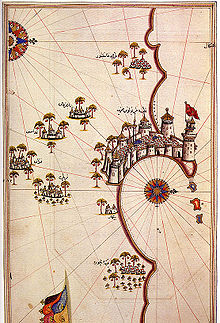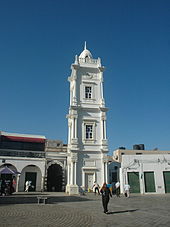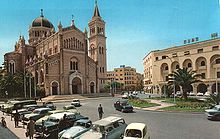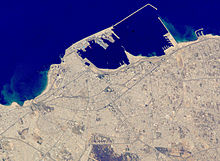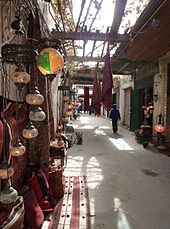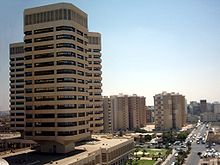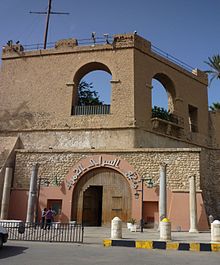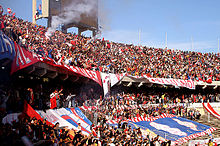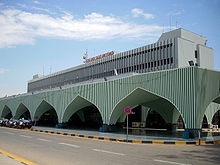- Tripoli
-
Tripoli
طرابلس الغرب
Tarabulus al-GharbTop:: That El Emad Towers; Middle: Martyrs' Square; Bottom left: Marcus Aurelius Arch; Bottom right: Souq al-Mushir – Tripoli Medina Location in Libya Coordinates: 32°54′8″N 13°11′9″E / 32.90222°N 13.18583°ECoordinates: 32°54′8″N 13°11′9″E / 32.90222°N 13.18583°E Country Libya Region Tripolitania District Tripoli First settled 7th century BC (as Oea) Founder Phoenicians Area - Total 400 km2 (154.4 sq mi) Elevation 81 m (266 ft) Population (2011)[1] - Total 1.8 million - Density 4,500/km2 (11,654.9/sq mi) Time zone EET (UTC+2) Area code(s) 21 Tripoli is the capital and largest city in Libya. It is also known as Western Tripoli (Arabic: طرابلس الغرب Ṭarābulus al-Gharb), to distinguish it from Tripoli, Lebanon. It is affectionately called The Mermaid of the Mediterranean (Arabic: عروسة البحر ʼarūsat el-baḥr; lit: "bride of the sea"), describing its turquoise waters and its whitewashed buildings. Tripoli (English pronunciation: /ˈtrɪpɵli/) is a Greek name that means "Three Cities", introduced in Western European languages through Italian Tripoli. It is in Arabic: طرابلس Ṭarābulus
 pronunciation (help·info), Libyan Arabic: Ṭrābləs
pronunciation (help·info), Libyan Arabic: Ṭrābləs  pronunciation (help·info), Berber: Ṭrables, from Ancient Greek: Τρίπολις Trípolis. As of 2011, the Tripoli metropolitan area (district area) had a population of 1.8 million. The city is located in the northwest part of the country on the edge of the desert, on a point of rocky land projecting into the Mediterranean and forming a bay.
pronunciation (help·info), Berber: Ṭrables, from Ancient Greek: Τρίπολις Trípolis. As of 2011, the Tripoli metropolitan area (district area) had a population of 1.8 million. The city is located in the northwest part of the country on the edge of the desert, on a point of rocky land projecting into the Mediterranean and forming a bay.The city includes the Port of Tripoli and the country's largest commercial and manufacturing centre. It is also the site of the University of Tripoli. The vast Bab al-Aziziyah barracks, which includes the former family compound of Muammar Gaddafi, is also located in the city; Gaddafi largely ruled the country from his residence in this barracks.
Tripoli was founded in the 7th century BC by the Phoenicians, who named it Oea.[2] Due to the city's long history, there are many sites of archaeological significance in Tripoli. The climate is typical Mediterranean, with hot, dry summers, and cool winters with modest rainfall. "Tripoli" may also refer to the shabiyah (top-level administrative division in the current Libyan system), Tripoli District.
Contents
History
The city was founded in the 7th century BC, by the Phoenicians, who gave it the Libyco-Berber name Oea (or Wy't),[3] suggesting that the city may have been built upon an existing native town. The Phoenicians were probably attracted to the site by its natural harbor, flanked on the western shore by the small, easily defensible peninsula, on which they established their colony. The city then passed into the hands of the rulers of Cyrenaica (a Greek colony on the North African shore, east of Tripoli, halfway to Egypt), although the Carthaginians later wrested it from the Greeks.
By the later half of the 2nd century BC it belonged to the Romans, who included it in their province of Africa, and gave it the name of Regio Syrtica. Around the beginning of the 3rd century AD, it became known as the Regio Tripolitana, meaning "region of the three cities", namely Oea (i.e., modern Tripoli), Sabratha and Leptis Magna. It was probably raised to the rank of a separate province by Septimius Severus, who was a native of Leptis Magna.
In spite of centuries of Roman habitation, the only visible Roman remains, apart from scattered columns and capitals (usually integrated in later buildings), is the Arch of Marcus Aurelius from the 2nd century AD. The fact that Tripoli has been continuously inhabited, unlike e.g., Sabratha and Leptis Magna, has meant that the inhabitants have either quarried material from older buildings (destroying them in the process), or built on top of them, burying them beneath the streets, where they remain largely un-excavated.
There is evidence to suggest that the Tripolitania region was in some economic decline during the 5th and 6th centuries, in part due to the political unrest spreading across the Mediterranean world in the wake of the collapse of the western Roman empire, as well as pressure from the invading Vandals.
According to al-Baladhuri, Tripoli was, unlike Western North Africa, taken by the Muslims very early after Alexandria, in the 22nd year of the Hijra, that is between 30 November 642 and 18 November 643. Following the conquest, Tripoli was ruled by dynasties based in Cairo, Egypt (first the Fatimids, and later the Mamluks). For some time it was a part of the Berber Almohad empire and of the Hafsids kingdom. It was part of the Ottoman Empire between the 16th and 19th centuries.
16th to 19th centuries
In 1510, it was taken by Don Pedro Navarro, Count of Oliveto for Spain, and, in 1523, it was assigned to the Knights of St. John, who had lately been expelled by the Ottoman Turks from their stronghold on the island of Rhodes. Finding themselves in very hostile territory, the Knights enhanced the city's walls and other defenses. Though built on top of a number of older buildings (possibly including a Roman public bath), much of the earliest defensive structures of the Tripoli castle (or "Assaraya al-Hamra", i.e., the "Red Castle") are attributed to the Knights of St John.
Having previously combated piracy from their base on Rhodes, the reason that the Knights were given charge of the city was to prevent it from relapsing into the nest of Barbary pirates as it had been prior to the Spanish occupation. The disruption the pirates caused to the Christian shipping lanes in the Mediterranean had been one of the main incentives for the Spanish conquest of the city.
The knights kept the city with some trouble until 1551, when they were compelled to surrender to the Ottomans, led by Muslim Turk Turgut Reis.[4] Turgut Reis served as pasha of Tripoli, during his rule he adorned and built up the city, making it one of the most impressive cities along the North African Coast.[5] Turgut was also buried in Tripoli after his death in 1565. His body was taken from Malta, where he had fallen during the Ottoman siege of the island, to a tomb in the mosque he had established close to his palace in Tripoli. The palace has since disappeared (supposedly it was situated between the so called "Ottoman prison" and the arch of Marcus Aurelius), but the mosque, along with his tomb, still stands, close to the Bab Al-Bahr gate.
After the capture by the Ottoman Turks, Tripoli once again became a base of operation for Barbary pirates. One of several Western attempts to dislodge them again was a Royal Navy attack under John Narborough in 1675, of which a vivid eye-witness account has survived.[6] Effective Ottoman rule during this period (1551–1711) was often hampered by the local Janissary corps. Intended to function as enforcers of local administration, the captain of the Janissaries and his cronies were often the de facto rulers.
In 1711, Ahmed Karamanli, a Janissary officer of Turkish origin, killed the Ottoman governor, the "Pasha", and established himself as ruler of the Tripolitania region. By 1714, he had asserted a sort of semi-independence from the Ottoman Sultan, heralding in the Karamanli dynasty. The Pashas of Tripoli were expected to pay a regular tributary tax to the Sultan, but were in all other aspects rulers of an independent kingdom. This order of things continued under the rule of his descendants, accompanied by the brazen piracy and blackmailing until 1835, when the Ottoman Empire took advantage of an internal struggle and re-established its authority.
The Ottoman province (vilayet) of Tripoli (including the dependent sanjak of Cyrenaica) lay along the southern shore of the Mediterranean between Tunisia in the west and Egypt in the east. Besides the city itself, the area included Cyrenaica (the Barca plateau), the chain of oases in the Aujila depression, Fezzan and the oases of Ghadames and Ghat, separated by sandy and stony wastelands.
Barbary Wars
In the early part of the 19th century, the regency at Tripoli, owing to its piratical practices, was twice involved in war with the United States. In May 1801, the pasha demanded an increase in the tribute ($83,000) which the US government had been paying since 1796 for the protection of their commerce from piracy under the 1796 Treaty with Tripoli. The demand was refused, and a naval force was sent from the United States to blockade Tripoli.
The First Barbary War dragged on for four years. In 1803, Tripolitan fighters captured the US frigate Philadelphia and took its commander, Captain William Bainbridge, and the entire crew as prisoners. This was after the Philadelphia was run aground when the captain tried to navigate too close to the port of Tripoli. After several hours aground and Tripolitan gun boats firing upon the Philadelphia, though none ever struck the Philadelphia, Captain Bainbridge made the decision to surrender. The Philadelphia was later turned against the Americans and anchored in Tripoli Harbor as a gun battery while her officers and crew were held prisoners in Tripoli. The following year, US Navy Lieutenant Stephen Decatur led a successful nighttime raid to retake and burn the ship. Decatur's men set fire to the Philadelphia and escaped.
The most colorful incident in the war was the expedition undertaken by William Eaton with the object of replacing the pasha with an elder brother living in exile, who had promised to accede to all the wishes of the United States. Eaton, at the head of a crew of 500 US Marines, Greek, Arab and Turkish Mercenaries, marched across the desert from Alexandria, Egypt and with the aid of American ships, succeeded in capturing Derna. Soon afterward, on 3 June 1805, peace was concluded. The pasha ended his demands and received $60,000 as ransom for the Philadelphia prisoners under the 1805 Treaty with Tripoli.
In 1815, in consequence of further outrages and due to the humiliation of the earlier defeat, Captains Bainbridge and Stephen Decatur, at the head of an American squadron, again visited Tripoli and forced the pasha to comply with the demands of the United States. See Second Barbary War.
Late Ottoman era
In 1835, the Ottomans took advantage of a local civil war to reassert their direct authority. After that date, Tripoli was under the direct control of the Sublime Porte. Rebellions in 1842 and 1844 were unsuccessful. After the French occupation of Tunisia (1881), the Ottomans increased their garrison in Tripoli considerably.
Italian era
Italy had long claimed that Tripoli fell within its zone of influence and that Italy had the right to preserve order within the state.[7] Under the pretext of protecting its own citizens living in Tripoli from the Ottoman Government, it declared war against the Ottomans on 29 September 1911, and announced its intention of annexing Tripoli. On 1 October 1911, a naval battle was fought at Prevesa, Greece, and three Ottoman vessels were destroyed.
By the Treaty of Lausanne, Italian sovereignty was acknowledged by the Ottomans, although the Caliph was permitted to exercise religious authority. Italy officially granted autonomy after the war, but gradually occupied the region. Originally administered as part of a single colony, Tripoli and its surrounding province were a separate colony from 26 June 1927 to 3 December 1934, when all Italian possessions in North Africa were merged into one colony. By 1938, Tripoli had 108,240 inhabitants, including 39,096 Italians.[8]
Tripoli was controlled by Italy until 1943 when the provinces of Tripolitania and Cyrenaica were captured by Allied forces and placed under British administration. The city was governed by the British until independence in 1951. Under the terms of the 1947 peace treaty with the Allies, Italy relinquished all claims to Libya.[9]
Gaddafi era
On 15 April 1986, U.S. President Ronald Reagan ordered major bombing raids, dubbed Operation El Dorado Canyon, against Tripoli and Benghazi, killing 45 Libyan military and government personnel as well as 15 civilians. This strike followed US interception of telex messages from Libya's East Berlin embassy suggesting the involvement of Libyan leader Muammar al-Gaddafi in a bomb explosion on 5 April in West Berlin's La Belle discotheque, a nightclub frequented by US servicemen. Among the alleged fatalities of the 15 April retaliatory attack by the United States was Gaddafi's adopted daughter, Hannah.
United Nations sanctions against Libya were lifted in 2003, which increased traffic through the Port of Tripoli and had a positive impact on the city's economy.
2011 Libyan civil war
See also: 2011 Libyan civil war, Timeline of the 2011 Libyan civil war, and Battle of Tripoli (2011)In February and March 2011, Tripoli witnessed intense anti-government protests and violent government responses resulting in hundreds killed and wounded. The city's Green Square was the scene of some of the protests. The anti-Gaddafi protests were eventually crushed, and Tripoli was the site of pro-Gaddafi rallies.[10]
The city defenses loyal to Gaddafi included the military headquarters at Bab al-Aziziyah (where Gaddafi's main residence was located) and the Mitiga International Airport. At the latter, on 13 March, Ali Atiyya, a colonel of the Libyan Air Force, defected and joined the revolution.[11]
In late February, rebel forces took control of Zawiya, a city approximately 50 kilometres (31 miles) to the west of Tripoli, thus increasing the threat to pro-Gaddafi forces in the capital. During the subsequent battle of Zawiya, loyalist forces besieged the city and eventually recaptured it by 10 March.[citation needed]
As the 2011 military intervention in Libya commenced on 19 March to enforce a U.N. no-fly zone over the country, the city once again came under air attack. It was the second time that Tripoli was bombed since the 1986 U.S. airstrikes, and the second time since the 1986 airstrike that bombed Bab al-Aziziyah, Gaddafi's heavily fortified compound.[citation needed]
In July and August, Libyan online revolutionary communities posted tweets and updates on attacks of rebel fighters on loyalist vehicles and checkpoints. In one such attack, Saif al-Islam Gaddafi and Abdullah Senussi were targets.[citation needed] The regime, however, denied revolutionary activity inside the capital.
Several months after the initial uprising, rebel forces in the Nafusa Mountains advanced towards the coast, retaking Zawiya and reaching Tripoli on 21 August. Urban combat ensued. At midnight of the 21st the symbolic Green Square, immediately renamed Martyrs' Square by the rebels, was taken under rebel control and Gaddafi propaganda posters were torn down and burned.[citation needed]
During a radio address on 1 September, Gaddafi declared that the capital of Great Socialist People's Libyan Arab Jamahiriya was moved from Tripoli to Sirte, after rebels had taken control of Tripoli. On October 20, 2011, Gaddafi was captured and killed in Sirte, bringing an end to his nearly 42-years of rule.
Law and government
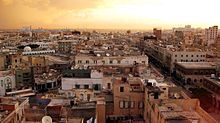 The old medina in Central Tripoli; There are 29 Local People's Congresses within the city boundaries.
The old medina in Central Tripoli; There are 29 Local People's Congresses within the city boundaries.
Tripoli and its surrounding suburbs all lie within the Tripoli sha'biyah (district). In accordance with Libya's former Jamahiriya political system, Tripoli comprises Local People's Congresses where, in theory, the city's population discuss different matters and elect their own people's committee; at present[when?] there are 29 Local People's Congresses. In reality, the former revolutionary committees severely limited the democratic process by closely supervising committee and congress elections at the branch and district levels of governments, Tripoli being no exception.
Tripoli is sometimes referred to as "the de-jure capital of Libya" because none of the country's ministries are actually located in the capital. Even the former National General People's Congress was held annually in the city of Sirte rather than in Tripoli. As part of a radical decentralization programme undertaken by Gaddafi in September 1988, all General People's Committee secretariats (ministries), except those responsible for foreign liaison (foreign affairs) and information, were moved outside of Tripoli. According to diplomatic sources, the former Secretariat for Economy and Trade was moved to Benghazi; the Secretariat for Health to Kufra; and the remainder, excepting one, to Sirte, Muammar al-Gaddafi's birthplace. In early 1993 it was announced that the Secretariat for Foreign Liaison and International Co-operation was to be moved to Ra's Lanuf. The National Transitional Council (N.T.C.), which took full control of Libya in October 2011, will probably abolish this Gaddafi-era system of national and local government.
Geography
Tripoli lies at the western extremity of Libya close to the Tunisian border, on the continent of Africa. Over a thousand kilometres separates Tripoli from Libya's second largest city, Benghazi. Coastal oases alternate with sandy areas and lagoons along the shores of Tripolitania for more than 300 kilometres (190 mi).
Until 2007, the "Sha'biyah" included the city, its suburbs and their immediate surroundings. In older administrative systems and throughout history, there existed a province ("muhafazah"), state ("wilayah") or city-state with a much larger area (though not constant boundaries), which is sometimes mistakenly referred to as Tripoli but more appropriately should be called Tripolitania.
As a District, Tripoli borders the following district:
- Murqub – east
- Jabal al Gharbi – south
- Jafara – southwest
- Zawiya – west
Climate
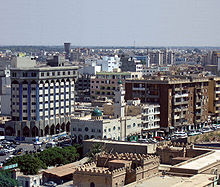 A view of the Tripoli skyline from the Corinthia Hotel Tripoli. In the foreground is the old tobacco factory.
A view of the Tripoli skyline from the Corinthia Hotel Tripoli. In the foreground is the old tobacco factory.
A coastal lowland city, Tripoli has dominant Mediterranean climatic influences. Its summers are hot with temperatures that often exceed 38 °C (100 °F); average July temperatures are between 22 °C (72 °F) and 33 °C (91 °F). In December, temperatures have reached as low as 1 °C (34 °F), but the average remains at between 9 °C (48 °F) and 18 °C (64 °F). The average annual rainfall is less than 400 millimetres (16 inches), and can be very erratic.[12]
For example, epic floods in 1945 left Tripoli under water for several days, but two years later an unprecedented drought caused the loss of thousands of head of cattle. Deficiency in rainfall is no doubt reflected in an absence of permanent rivers or streams in the city as well as an absence throughout the entire country. The allocation of limited water is considered of sufficient importance to warrant the existence of the Secretariat of Dams and Water Resources, and damaging a source of water can be penalized by a heavy fine or imprisonment.[citation needed]
The Great Manmade River, a network of pipelines that transport water from the desert to the coastal cities, supplies Tripoli with its water.[13] The grand scheme was initiated by Gaddafi in 1982 and has had a positive impact on the city's inhabitants.[citation needed]
Tripoli is dotted with public spaces, but none fit under the category of large city parks. Martyrs' Square, located near the waterfront is scattered with palm trees, the most abundant plant used for landscaping in the city. The Tripoli Zoo, located south of the city centre, is a large reserve of plants, trees and open green spaces and is the country's biggest zoo.[citation needed]
Climate data for Tripoli, 1961–1990 Month Jan Feb Mar Apr May Jun Jul Aug Sep Oct Nov Dec Year Record high °C (°F) 32
(90)34
(93)38
(100)42
(108)43
(109)48
(118)47
(117)48
(118)46
(115)42
(108)37
(99)31
(88)48
(118)Average high °C (°F) 17.9
(64.2)19.1
(66.4)20.7
(69.3)23.7
(74.7)27.1
(80.8)32.4
(90.3)33.7
(92.7)33.6
(92.5)31.0
(87.8)27.7
(81.9)23.3
(73.9)19.3
(66.7)26.4 Average low °C (°F) 8.9
(48.0)9.5
(49.1)11.2
(52.2)13.7
(56.7)16.7
(62.1)20.1
(68.2)21.7
(71.1)22.7
(72.9)21.4
(70.5)18.0
(64.4)13.4
(56.1)9.9
(49.8)15.6 Precipitation mm (inches) 62.1
(2.445)32.2
(1.268)29.6
(1.165)14.3
(0.563)4.6
(0.181)1.3
(0.051)0.7
(0.028)0.1
(0.004)16.7
(0.657)46.6
(1.835)58.2
(2.291)67.5
(2.657)333.9
(13.146)Source: World Meteorological Organization[12] Economy
Tripoli is one of the main hubs of Libya's economy along with Misrata. It is the leading centre of banking, finance and communication in the country and is one of the leading commercial and manufacturing cities in Libya. Many of the country's largest corporations locate their headquarters and home offices in Tripoli as well as the majority of international companies.[citation needed]
Major manufactured goods include processed food, textiles, construction materials, clothing and tobacco products. Since the lifting of sanctions against Libya in 1999 and again in 2003, Tripoli has seen a rise in foreign investment as well as an increase in tourism. Increased traffic has also been recorded in the city's port as well as Libya's main international airport, Tripoli International.[citation needed]
The city is home to the Tripoli International Fair, an international industrial, agricultural and commercial event located on Omar Muktar Street. One of the active members of the Global Association of the Exhibition Industry (UFI), located in the French capital Paris, the international fair is organized annually and takes place from 2-12 April. Participation averages around 30 countries as well as more than 2000 companies and organizations.[citation needed]
Since the rise in tourism and influx of foreign visitors, there has been an increased demand for hotels in the city. To cater for these increased demands, the Corinthia Bab Africa Hotel located in the central business district was constructed in 2003 and is the largest hotel in Libya. Other high end hotels in Tripoli include the Al Waddan Intercontinental and the Tripoli Radisson Blu Hotel as well as others.[14]
Companies with head offices in Tripoli include Afriqiyah Airways and Libyan Airlines.[15][16] Buraq Air has its head office on the grounds of Mitiga International Airport.[17]
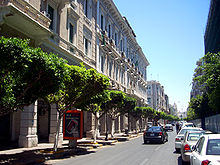 Emhemmed Elmgharief Street in central Tripoli has some of the best examples of Italianate colonial architecture in Tripoli.
Emhemmed Elmgharief Street in central Tripoli has some of the best examples of Italianate colonial architecture in Tripoli.
Main sights
The city's old town, the Medina, is still unspoiled by mass-tourism, though it was increasingly exposed to more and more visitors from abroad, following the lifting of the UN embargo in 2003. However, the walled Medina retains much of its serene old-world ambiance. The Red Castle Museum (Assaraya al-Hamra), a vast palace complex with numerous courtyards, dominates the city skyline and is located on the outskirts of the Medina. There are some classical statues and fountains from the Ottoman period scattered around the castle.
Three gates provided access to the old town: Bab Zanata in the west, Bab Hawara in the southeast and Bab Al-Bahr in the north wall. The city walls are still standing and can be climbed for good views of the city. The bazaar is also known for its traditional ware; fine jewellery and clothes can be found in the local markets.
There are a number of buildings that were constructed by the Italian colonial rulers and later demolished under Gaddafi. They included the Royal Miramare Theatre,[18] next to the Red Castle, and Tripoli Railway Central Station.[19] Tripoli Cathedral, constructed by the Italian colonial authorities during the 1920s, was converted into a mosque in the early 1970s. The building was extensively remodelled at this time.
Colleges and universities
The largest university in Tripoli, Al Fateh University, is a public university providing free education to the city's inhabitants. Private universities and colleges have also begun to crop up in the last few years.
Universities in Tripoli include:
- University of Libya – The largest university in Tripoli
- Al Fateh University for Medical Sciences – includes the following faculties: Medicine, Pharmacy, Dentistry and nursing (which was previously a small institute)
- Open University
- Informatics Tripoli
Sports
Football (soccer) is the most popular sport in the Libyan capital. Tripoli is home of the most prominent football clubs in Libya, Al Madina, Al Ahly (Tripoli) and Al Ittihad.
Other sports clubs based in Tripoli include Al Wahda and Addahra.
The city also played host to the Italian Super Cup in 2002, a match in which Juventus (Italian Serie A champion holder) defeated Parma F.C. (Coppa Italia holder) 2–1.
International relations
Twin towns — Sister cities
Tripoli is twinned with:
 Bogotá
Bogotá Algiers
Algiers Beirut
Beirut Belo Horizonte (since 2003)
Belo Horizonte (since 2003)
Transport
Tripoli International Airport is the largest airport in Tripoli and Libya. Tripoli is the interim destination of a railway from Sirte under construction in 2007.[20]
See also
- 1986 Berlin discotheque bombing
- 2011 Libyan protests
- Barbary treaties
- First Barbary War
- Second Barbary War
- Gran Premio di Tripoli
References and notes
- ^ Table (undated). "Libya" (requires Adobe Flash Player). Der Spiegel. Retrieved 31 August 2011.
- ^ Hopkins, Daniel J. (1997). Merriam-Webster's Geographical Dictionary (Index). Merriam-Webster. ISBN 0-8777-9546-0.
- ^ Septimus Severus page 2.
- ^ Reynolds, Clark G. (1974). Command of the Sea – The History and Strategy of Maritime Empires. Morrow. pp. 120–121. ISBN 0688002676, 978-0-688-00267-1. "Ottomans extended their western maritime frontier across North Africa under the naval command of another Greek Moslem, Torghoud (or Dragut), who succeeded Barbarossa upon the latter's death in 1546."
- ^ Braudel, Fernand (1995). The Mediterranean and the Mediterranean World in the Age of Philip II, Volume 2. University of California Press. pp. 908–909. ISBN 0520203305, 978-0-520-20330-3. "Of all the corsairs who preyed on Sicilian wheat, Dragut (Turghut) was the most dangerous. A Greek by birth, he was now about fifty years old and behind him lay a long and adventurous career including four years in the Genoese galleys."
- ^ The Diary of Henry Teonge Chaplain on Board HM's Ships Assistance, Bristol and Royal Oak 1675–1679. The Broadway Travellers. Edited by Sir E. Denison Ross and Eileen Power. London: Routledge, [1927] 2005. ISBN 978-0-415-34477-7.
- ^ Charles Wellington Furlong (December 1911). "The Taking Of Tripoli: What Italy Is Acquiring". The World's Work: A History of Our Time XXIII: 165–176. http://books.google.com/books?id=Vv--PfedzLAC&pg=PA165. Retrieved 10 July 2009.
- ^ The Statesman's Yearbook 1948. Palgrave Macmillan. p. 1040.
- ^ Hagos, Tecola W. (November 20, 2004). "Treaty Of Peace With Italy (1947), Evaluation And Conclusion". Ethiopia Tecola Hagos. Retrieved 18 July 2006.
- ^ Pro-Gaddafi demonstrations in Tripoli | Libya February 17th
- ^ "Breaking: Body of Al Jazeera Cameraman Ali Al Jabir Arrives in Doha". Libyafeb17.com. 13 March 2011. http://www.libyafeb17.com/2011/03/crowd-mourns-ali-hassan-al-jabir/. Retrieved 20 March 2011.
- ^ a b "Weather Information for Tripoli". World Meteorological Organization. May 2011. http://worldweather.wmo.int/157/c01179.htm. Retrieved 15 October 2011.
- ^ Watkins, John (18 March 2006). "Libya's Thirst for 'Fossil Water'". BBC News. http://news.bbc.co.uk/1/hi/sci/tech/4814988.stm#map. Retrieved 10 September 2006.
- ^ Libya Opportunities for British goods and services exporters, Accessed Feb 18, 2010
- ^ "Contact Us." Afriqiyah Airways. Retrieved on 9 November 2009.
- ^ "Libyan Airlines." Arab Air Carriers Organization. Retrieved on 9 November 2009.
- ^ "Company Profile." Buraq Air. Retrieved on 14 May 2010.
- ^ File
- ^[unreliable source?] "File" (in Italian). It.wikipedia.org. 14 March 2011. http://it.wikipedia.org/wiki/File:Tripoli_Stazione_Centrale.jpg. Retrieved 20 March 2011.
- ^ Briginshaw, David (1 January 2001). "Libya's First Two Railway Lines Start To Take Shape". International Railway Journal. Retrieved 30 December 2007.
- Includes text from Collier's New Encyclopedia (1921).
Further reading
- London, Joshua E. (2005). Victory in Tripoli – How America's War with the Barbary Pirates Established the U.S. Navy and Shaped a Nation New Jersey: John Wiley & Sons, Inc..
- Nora Lafi (2002). Une ville du Maghreb entre Ancien régime et réformes ottomanes. Genèse des institutions municipales à Tripoli de Barbarie (1795–1911). Paris: L'Harmattan. 305 p. Amamzon.fr.
External links
- Tripoli travel guide from Wikitravel
- Living tips and advices for Tripoli.
- Tripoli at goruma (German). Machine translation by Freetranslation.com.
- Google Maps showing "greater" Tripoli, roughly bounded by Tajura on the east, Janzur on the west, Qaşr Bin Ghashīr on the south. (View at 1024x768 screen resolution or adjust the map to the described boundaries).
Tripoli Buildings and
structuresHotelsBab el Bahr Hotel · Corinthia Hotel Tripoli · Grand Hotel Tripoli · Hotel Al Mehari · Hotel Casinò Uaddan · Rixos Al Nasr · JW Marriott Tripoli · Four Points by Sheraton Tripoli · Radisson Blu Al Mahary
MosquesGurgi Mosque · Tripoli Cathedral
MuseumsEpigraphy Museum of Tripoli · Ethnographic Museum of Tripoli · Islamic Museum of Tripoli · Karamanly House Museum · Natural History Museum of Tripoli · Prehistory Museum of Tripoli · Red Castle Museum
Stadia7 October Stadium · Ali Alsgozy Stadium · GMR Stadium · June 11 Stadium
OtherAbu Salim prison · University of Tripoli · Bab al-Azizia · Darghouth Turkish Bath · Fist Crushing a U.S. Fighter Plane Sculpture · Martyrs' Square, Tripoli · Libyan Studies Center · People's Hall · Tarabulus Zoo Park · Tripoli Central Hospital · Tripoli Zoo
History Siege of Tripoli (1551) · Treaty of Tripoli · Battle of Tripoli Harbor · Battle of Tripoli (1825) · 2011 Tripoli clashes · Battle of Tripoli (2011) · Tripoli UprisingSport Al Jamarek Tripoli · Al-Ittihad Club · Alahly Tripoli S.C. · Almadina S.C. · Alwahda · Aschat S.C. · Tripoli Grand PrixOther Phoenician cities and colonies Algeria: Hippo Regius · Ikosium · Guelma · Iol · Rus Icada · Rus Azuz · Iom · Honaine · Pomoria · Cirta · Rus Ucurru · Rus Aghoun · Rus Ipir · Qart Ina · Siga · Timgad · Lambese · Djémila · Uzinaza · Cuicul · Altava · Igligili · Imonium · Sitifis · Auzia · Rapidum · Portus Magnus · Tipaza · Cyprus: Kition · Italy: Karalis · Lilybaeum · Motya · Nora · Olbia · Panormus · Solki · Soluntum · Tharros · Lebanon: Amia · Ampi · Arqa · Baalbek · Berut · Botrys · Gebal · Sarepta · Sur · Sydon · Tripolis · Libya: Leptis Magna · Oea · Sabratha · Malta: Gozo · Mauritania: Cerne · Morocco: Arambys · Caricus Murus · Lixus · Tingis · Portugal: Olissipona · Ossonoba · Spain: Abdera · Abyla · Akra Leuke · Gadir · Herna · Ibossim · Mahón · Malaca · Onoba · Qart Hadašt · Rusadir · Sexi · Syria: Amrit · Arwad · Safita · Ugarit · Tunisia: Carthage · Hadrumetum · Hippo Diarrhytos · Kerkouane · Leptis Parva · Thanae · Thapsus · Utica · Turkey: Myriandrus · Phoenicus · Gibraltar
Districts of Libya since 2007 Districts of Libya 2001–2007 Ajdabiya · Bani Walid · Benghazi · Butnan · Derna · Ghat · Ghadames · Gharyan · Hizam al Akhdar · Jabal al Akhdar · Jafara · Jufra · Kufra · Marj · Misrata · Mizda · Murqub · Murzuq · Nalut · Nuqat al Khams · Quba · Sabha · Sabratha & Sorman · Sirte · Tajura & Arba‘ · Tarhuna & Msalata · Tripoli · Wadi al Hayaa · Wadi al Shatii · Al Wahat · Yafran · ZawiyaAdministrative seats of the districts of Libya (since 2007) Capitals of Arab countries Africa Asia Capitals of Africa Abuja, Nigeria
Accra, Ghana
Addis Ababa, Ethiopia
Algiers, Algeria
Antananarivo, Madagascar
Asmara, Eritrea
Bamako, Mali
Bangui, Central African Republic
Banjul, Gambia
Bissau, Guinea-Bissau
Bloemfontein, South Africa 1
Brazzaville, Rep. of the Congo
Bujumbura, Burundi
Cairo, Egypt
Cape Town, South Africa 2
Conakry, GuineaPort Louis, Mauritius
Porto-Novo, Benin
Praia, Cape Verde
Pretoria, South Africa 3
Rabat, Morocco
Saint-Denis, Réunion
São Tomé, São Tomé and Príncipe
Tripoli, Libya
Tunis, Tunisia
Victoria, Seychelles
Windhoek, Namibia
Yaoundé, Cameroon
Yamoussoukro, Côte d'Ivoire1 Judicial. 2 Parliamentary. 3 Executive. 4 An unrecognised or partially-recognised state. Neighborhoods of Tripoli Al Hanshir · Bab Akkarah · Bab Ben Ghashir · Bin Ashur · Fashloom · Garden City · Martyrs' Square · Old Medina · Port of Tripoli · Tajura · Tarabulus Zoo Park · Zawiyat al-DahmaniCategories:- Tripoli
- Populated places in Tripoli District
- Mediterranean port cities and towns in Libya
- Capitals in Africa
- Populated places established in the 7th century BC
- Phoenician colonies
- Barbary Wars
- Former Italian colonies
- 2011 Libyan civil war
- Populated places in Libya
Wikimedia Foundation. 2010.




